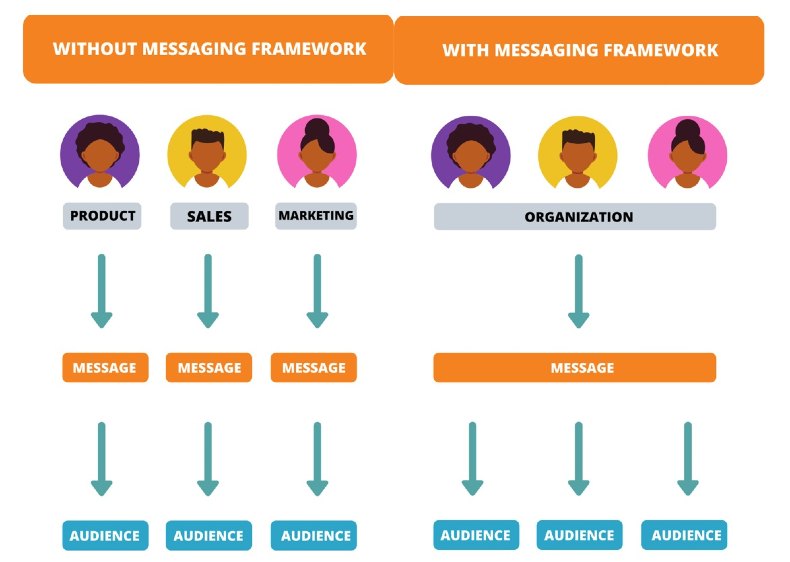Whether you are launching a company, product, or service, a messaging framework is a core element you cannot do without.
Your messaging framework captures the reason for the existence of your business. Going through the exercise of creating it helps you to better understand your company—not just what it does but also how and why. Moreover, it helps you communicate all that to the market with effective messages.
What is a messaging framework?
A messaging framework is a structured representation of what your company and products stand for. The framework exercise is a systematic way of defining the value you bring to your customers.
It not only communicates the what, why, and how of your business to its target audience but also becomes a step-by-step guideline for company introspection about the true value of your business.
Why do you need a messaging framework?
As you set out to define your messaging framework, think of the famous saying, "The journey is more important than the destination." The process of envisioning, formulating, and articulating your company's core message allows you to better understand your offerings and the value they bring to your customers. In turn, that helps to create customer commitment to your business.
A well-formed framework should give all company stakeholders—from Product and Marketing to Sales and Customer Support—a better sense of purpose, and lay the foundation for your mission statement.
A messaging framework also forms the foundation for your content strategy, your content marketing plan... in fact, all your content efforts. It's a starting point for marketing campaigns, sales enablement content, whitepapers, and website pages.
With a framework...
- Customers will know who you are and how you are different from other companies.
- Sales will know key differentiating factors.
- Marketing will have a solid foundation for future content resources.
- All teams will be aligned on the purpose and mission of the company.
By now we know that B2B buyers complete 70% of the purchase journey using their own independent research before they even speak to a sales rep. That means your sales and marketing messaging is more relevant than ever.
And with aligned messaging between them, marketing and sales teams are much more likely to close deals, and to be much more efficient at doing so.
Try this: Invite members from all your teams to meet together, and ask the representative of each department a few questions...
- What do we do?
- What is our goal?
- Who are our customers?
In most cases, you will hear very different answers from each representative. That range of responses means there is an alignment gap. A clearly defined messaging framework will fill the gap and get everyone on the same page.

Illustration adapted from Hilary Marsh, Managing the Politics of Content
How do you create a messaging framework?
1. Speak to decision-makers
Set up one meeting with each of your stakeholders: the CEO, CTO, CMO, and head of Customer Support. During the meetings, listen their ideas about the company's brand value and target customer; try to create alignment around each concept.
Then, speak with the sales, marketing, and product teams to develop insights into each team's understanding of the customer.
In-depth discussions are an important exercise for creating and ensuring alignment, and they provide you with the data that indicates whether your messaging is on point and effective.
2. Understand the customer
Company messaging must reflect not only the company's own points of view but also customers' views, particularly about the value you provide to them. Dig deep to develop a nuanced understanding of who your customers are: Call them directly, survey them, and speak to multiple stakeholders in their organization.
3. Study your competitors
Understanding the market is vital to defining your own value proposition, developing your positioning, and crafting a positioning statement.
If a competitor is providing a service similar to yours, are you just doing a better job of delivering it or does it have features that your competitor's doesn't? A close analysis of your competitors' messaging will give you insight into the tone (playful, professional, friendly, authoritative?) and language you should be using.
Research competitors' case studies and testimonials to better understand their messaging and customers.
4. Define your messaging DNA
Your messaging DNA is made up of the foundational elements that hold up your framework like pillars—your unique brand values and customer benefits. They must be reiterated across all communication.
For instance, at my company, the pillars are alignment (internal and external), expertise (in product marketing and technology), and reliability (acting as an extended marketing arm for our clients).
Company pillars should reinforce all messaging at every stage and via all media and in all campaigns.
5. Map pain points to key messages
Don't dance around the point of your message; a good marketer goes straight for the jugular! The company behind a website that has a lot of information but doesn't give you a clear takeaway probably hasn't created a messaging framework.
Mapping messages to your customer's pain points is a winning formula. Defining the messages in the framework prior to creating your assets will set the right tone not just for your marketing team but also for your sales reps and support team.
What messaging assets should you have?
Once you complete the previous steps, you'll be ready to commence writing. Align your teams on your common framework and work on the following assets:
- Header. Summarize in 25 words what your company does. This is particularly effective when creating a website. Find words that communicate both who you are and what you do—and capture the attention of your potential lead within the first five seconds.
- Elevator pitch. Create an engaging and informative description of your company in 55-100 words that discusses the goals, mission, history, and achievements of your company. An elevator pitch is especially helpful to your PR team and executives, who should all use the same phrases so they reinforce the company's brand and values.
- Brand promise. In 10 words or less, define what you want people to remember about your company. In many cases, the brand promise is your tagline. In my company's case, the promise is "Alignment is at the core of everything we do"; it's not only directed at clients but also intended to reinforce our alignment message internally.
- Mission statement. This is a tough one. A lot of companies and startups choose to avoid it. The mission statement is a bigger idea than the brand promise; it involves the effect your organization wants to have on your community, society, or the world.
Defining it requires introspection and a deep understanding of the company, so it usually comes from the company's leaders.
* * *
A messaging framework will inspire your customers as well as your employees. A little work on developing one will go a long way, and you'll reap the benefits of both external and internal alignment.
More Resources on Building a Messaging Framework
Content as Customer Experience
Your Golden Ticket of Marketing (Hint: It's Not Your Website)
Positioning as the Foundation for Great Messages
Want to Build a Strong Brand? Get Messaging Right. Here's How...




